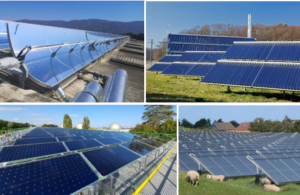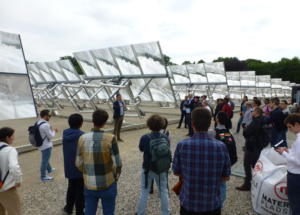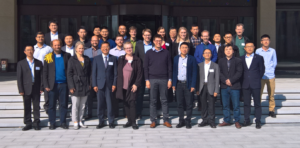Investigation of the boost effect of heat pumps in solar district heating
February 15, 2024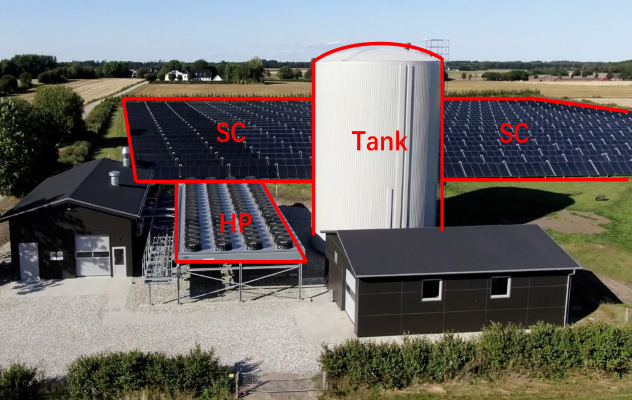
During their most recent meeting in Sweden in October the district heating experts from the IEA SHC Programme discussed the impact of integrating heat pumps into solar district heating systems with and without seasonal storage. Jianhua Fan from the Technical University of Denmark (DTU) analysed monitoring data from the Ørum district heating plant in Denmark (see photo). The researchers from the Unit for Energy Efficient Building of the University of Innsbruck used the seasonal storage model COMSOL to quantify the emission-saving potential of hybrid solar district heating systems. These researchers all participate in IEA SHC Task 68 on Efficient Solar District Heating Systems.
Photo: Aalborg CSP
The district heating system in the Danish town of Ørum is a good example to use for analysing the impact of a heat pump. A 2.5 MW air-to-water heat pump started operation in February 2021 in a district heating system that already included a 6,355 m2 flat plate collector field and a 1000 m3 storage tank. Detailed monitoring data exists for all three years from 2020 to 2022.
Heat pump economizer has several positive impacts
The heat pump works in parallel with the solar collector field and has a special feature (see figure 1): The heat pump includes an economizer that improves the overall efficiency by preheating the working fluid before it enters the evaporator. In the case of Ørum the economizer utilizes waste heat from the lower part of the solar storage tank that cannot be used in the district heating grid. This cools down the lower part of the tank, from where water is sent to the collector field. “We isolated the hours with the economizer on and off to investigate its influence on the overall performance of the hybrid district heating system”, explained Jianhua Fan, Associated Professor in the Department of Civil and Mechanical Engineering at the DTU.
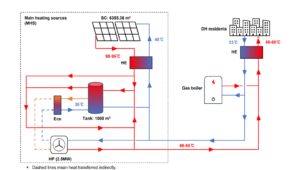
Figure 1: Flow diagram of the heating plant in Ørum after the installation of the heat pump at the end of 2020, which includes an economizer. A gas boiler acts as a backup for the district heating system. Source: Technical University of Denmark
The economizer has several positive impacts on the solar district heating system:
- The solar fraction increased from 23.8 % without the heat pump in 2020 to 25.9 % with the heat pump in 2022.
- Due to the cooling by the economizer, the maximum usable capacity of the tank increased from 80 MWh to about 95 MWh.
- The economizer also slightly increased the coefficient of performance of the heat pump from 3.33 to 3.53.
Fan drew a positive conclusion: “The heat pump has increased the system’s flexibility and reduced dependency on the gas boiler.” The collector field and the heat pump covered more than 70 % of the annual heat demand in 2021 and 2022. The annual heat generated by the gas boiler decreased from 9,936 MWh in 2020 to 2,432 MWh in 2022. Moreover, the heat pump decreased carbon emissions by consuming excess wind power.
Heat pumps allow better discharging of the seasonal storage
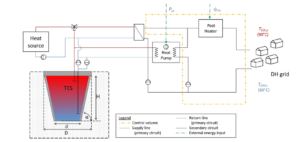
Figure 2: Scheme of a simulated district heating system with a buried thermal energy storage that can be discharged by the heat pump when the storage is no longer able to provide the target temperature required by the grid. The major heat source in this chart could be a solar collector field, a geothermal plant etc. Chart: University of Innsbruck
The researchers at the University of Innsbruck used a 2D COMSOL storage model to better understand the impact of buried thermal energy storage systems coupled with heat pumps in solar district heating systems. COMSOL allows the investigation of different geometries of seasonal storage and the impact of the envelope (i.e. thermal insulation) and ground properties in terms of losses.
The scientists compared two different storage models – a cylindrical tank and a shallow pit. High temperature differences between the storage water and the outside ambient conditions result in high thermal losses, which affect both the storage performance and the quality of the local ground conditions. In most of the existing underground thermal storage systems, the cover is the only insulated element of the envelope, but several publications show that the insulation of side walls and the bottom of the storage is essential to reduce thermal losses and avoid excessive increases in ground temperature.
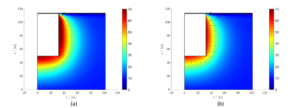
Figure 3: Ground temperature distribution in the tenth year of operation, for a storage tank without insulation on the side and the bottom (left) and with insulation on the side and the bottom (right). The cover is insulated in both variants.
Chart: University of Innsbruck
In their simulations the seasonal storage with the heat pump is operated in parallel to the key heat source (see figure 2). “Our simulations showed that the deep discharging of the seasonal storage tank by a heat pump has a major impact on the performance of the storage tank and the entire district heating system, as it can increase the storage efficiency, reduce the surrounding ground temperature and reduce the use of back-up plants, which are usually gas-fired, to cover the winter peak demand,” said Alice Tosatto from the Austrian University of Innsbruck, one of the authors of the scientific paper which describes the results and is titled: “Simulation-based performance evaluation of large-scale thermal energy storage coupled with heat pumps in district heating systems”.
Alice Tosatto from the Austrian University of Innsbruck
In addition to the energy analysis of storage as a component, the authors presented a study on the possible CO2 emission scenarios for the analysed district heating systems. Figure 4 presents two possible scenarios, one without thermal storage, where the winter peak is covered by gas-fired boilers, and a second one with thermal storage coupled with a heat pump. In this second case the saving in gas for the backup boilers needs to be offset against the additional electricity demand for heat pump operation. The heat pump capacity and the extent of its use play an important role in the emissions related to electricity. The more the heat pump is used, the more electrical energy is required to run it and the higher the related CO2 emissions. However, the total CO2 emissions are lower thanks to the reduced contribution from the gas boilers.
For the simulations, the authors used monthly CO2 emission factors for gas and grid electricity for Austria. In the specific analysed case described in the scientific paper quoted below they were able to prove various boost effects that heat pumps have in solar district heating systems:
- The storage tank efficiency rises by 6 % (from 87 %) compared to the reference case without a heat pump in the case of an insulated cylindrical storage tank and by 16 % (from 64 %) in the case of an insulated shallow pit heat storage tank.
- Due to the better discharge of the storage, the maximum ideal storage capacity utilization increases if the charging energy is also increased.
- The resulting ground temperature near pit heat storage is on average 5 K lower than in the reference case without a heat pump at a ground depth of 7 to 15 m.
The overall CO2 emission is analysed in the paper in two steps starting with a district heating system without TES and without a heat pump. In the first step an insulated seasonal storage is integrated into to the district heating. This measure decreases CO2 emissions by 33 % for the cylindrical tank and 29 % for the shallow pit. In the second step a 6 MW heat pump is integrated reducing the CO2 emissions by 65 % for the cylindrical tank and 57 % for the shallow pit.
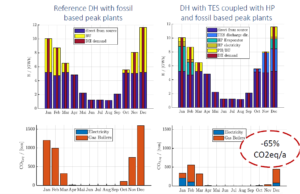
Figure 4: Energy balance (upper graphs) and CO2 emissions (lower graphs) for a reference district heating system on the left with a renewable heat source (dark blue) and the gas boiler (yellow) compared to a system variant on the right with a seasonal storage (TES) and a 6 MW heat pump. The energy contribution of the heat pump in the chart at the top right has been divided into evaporator energy (light green) and electricity for the compressor (light brown). The red bars show the district heating load in both upper graphs.
Charts: University of Innsbruck
Websites of organizations mentioned in this news article:
IEA SHC Programme: https://www.iea-shc.org/
IEA SHC Task 68 on Efficient Solar District Heating: https://task68.iea-shc.org
Technical University of Denmark: https://www.dtu.dk/english/
University of Innsbruck: https://www.uibk.ac.at/en/
Aalborg CSP: https://www.aalborgcsp.com/
Paper about CO2 simulations for DH coupled with heat pump and TES: https://doi.org/10.1016/j.est.2023.106721
